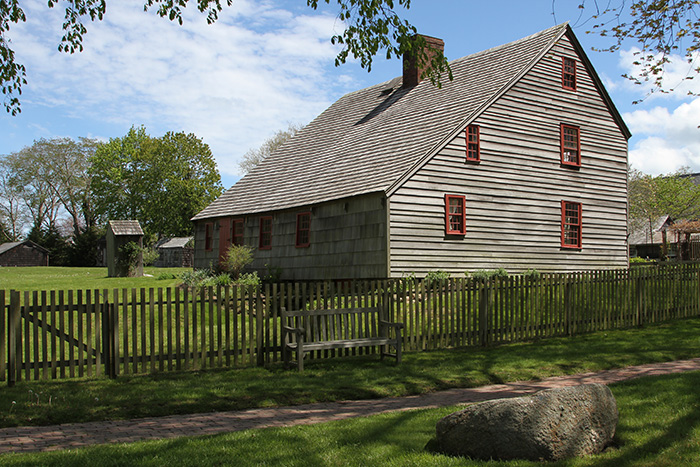Follow Our East Hampton Village Architectural Walking Tour

Whether someone is suffering from ichthyophobia (fear of fish), bathophobia (of depths), galeophobia (of sharks), or just plain old thalassophobia (of the ocean), not everyone likes the beach. Believe it or not, some of us haven’t ever been in the Atlantic Ocean.
Lucky for us less-than-brave souls, walking opportunities abound on the East End. Lucky for you, we’ve made a handy list of historic houses in East Hampton Village, starting at the south end of Main Street moving north. So lace up your walking shoes and get historic.

East Side of Main Street
Lyman Beecher House
86 Main Street
Rev. Lyman Beecher lived here from 1799 to 1810; he was an American Temperance Society co-founder and father of Uncle Tom’s Cabin author Harriet Beecher Stowe. Owner George Hand renovated the house in 1850 in the Greek Revival style. It’s now East Hampton Village Hall.
Huntting Inn
94 Main Street
The oldest part of the house was built for Rev. Nathaniel Huntting in 1699. It has been an inn since the American Revolution. David Gardiner described the “High merriment and frolicking, the oceans of flip, the cans of well-tempered punch and gin toddy” found there.
First Presbyterian Church of East Hampton
120 Main Street
The original building, constructed in 1861 was in the Romanesque revival style. The portico, bell tower and spire were added in 1960.
Presbyterian Manse
The manse—a “manse” is a home for a Presbyterian minister—was originally a small house built c. 1830 and enlarged in the 1880s.
Sherrill House
128 Main Street
This is a simple yet elegant Federal style house built about 1800 by Samuel Sherrill. An earlier Samuel Sherrill was shipwrecked off Long Island in 1670. Private house.
Frank Cartwright House
132 Main Street
This 1885 house was built in the Queen Anne style. Cartwright, a Mason, is buried in South End Cemetery. Private house.
Thomas Wickham House
134 Main Street
This early saltbox had a gable roof added about 1865. Thomas Wickham was a delegate to the Revolutionary Congress of New York in 1775. Dr. George Huntington, who named Huntington’s Disease, lived here.
James Arrowsmith House
144 Main Street
This 1872 Italianate house is known as “the Gingerbread House.” James Arrowsmith was a teacher at Clinton Academy. Private house.
Samuel G. Mulford House
146 Main Street
This type of house is often called a “single house” since they are only one room wide. Samuel G. Mulford and his wife are buried in South End Cemetery. Private house.

Guild Hall
158 Main Street
Designed by Aymar Embury and opened to the public in 1931, this Georgian style building is an art gallery and performing arts space.
Mulford Farm
10 James Lane
The house was built c. 1680 for Capt. Josiah Hobart. Samuel Mulford bought the house in 1711, and it remained in the family until 1948. It is now run by the East Hampton Historical Society.
Home Sweet Home
14 James Lane
The house, with its catslide roof, was built in the 1720s. The parlor paneling is attributed to c. 1750. John Howard Payne, a playwright and actor, who wrote the song, “Home, Sweet Home,” was supposed to have been inspired by this house. It belongs to East Hampton Village.
The Pantigo Windmill
James Lane
Built by Samuel Schellinger in 1804.
St Luke’s Episcopal Church
18 James Lane
Thomas Nash, the architect of this 1909 church, modeled it after All Saints in Maidstone, England.
Gardiner Windmill
This is an English style windmill built in 1804 by Nathaniel Dominy V.
This tiny house still sports its original 19th century door and windows. Private house.
The Hedges Inn
74 James Lane
The inn was built in 1873 by John D. Hedges as a boarding house. Mrs. Isabella Hedges was one of the founders of the Ladies’ Village Improvement Society.

West Side of Main Street
Col. Abraham Gardiner House
95 Main Street
This 1747 Georgian house was moved back from the street in 1924. Though Col. Gardiner was a loyal American, the house was occupied by British General Sir Henry Clinton during the Revolution. Now it is the headquarters of the Ladies’ Village Improvement Society
Osborn-Jackson House
101 Main Street
This house is named after its first and its last owners. It was built about 1720 as a small “single house” by Jonathan Osborn, it was expanded over the years, up until about 1880. Now it’s the headquarters of the East Hampton Historical Society.
Daniel Osborn House
109 Main Street
The Osborns were a very old East Hampton family. Two of their members were named Recompence and Bezaleel, names you don’t hear much these days! The Osborns owned this land starting in the 1660s. The current house, built about 1800, incorporates an earlier chimney. Private house.
Sarah Diodati Gardiner House
127 Main Street
This house was built in 1939 in the Spanish Romanesque style, on the site of an earlier Gardiner house, for Miss Gardiner, then the Proprietor of Gardiner’s Island. Private house.
Osborne Office
This 18th century house was moved farther away from the street in 1898. It has been a law office with an Osborne practicing in it ever since.
Jonathan Dayton House
143 Main Street
Now known as the 1770 House, the house was lived in from 1764 to 1842 by Jonathan Dayton. The house was almost certainly built around 1750, given that it has identical paneling to Home Sweet Home.
Hook School
This building was constructed around 1785 and may have been a school or an office. It is run by the East Hampton Historical Society.
Town House
151 Main Street
This 18th century school was moved here in 1958. East Hampton Historical Society owns it.

Clinton Academy
Built in 1784, the Academy has one of the first accredited high schools in New York State. The founder designed the school to echo the buildings at Yale University. It’s now the headquarters of the East Hampton Historical Society.
Edwards Drug Store
153 Main Street
This 1901 drugstore has a gambrel roof. It’s now the East Hampton Star offices.
East Hampton Library
159 Main Street
Aymar Embury, who designed Guild Hall, also architected the library.
George A. Osborne House
173 Main Street
This Queen Anne style cottage, built in the early 20th century, typifies an East Hampton summerhouse. Private house.
David B. Mulford House
177 Main Street
This circa-1680 house was moved to its present spot from Buell Lane. The house is known as Congress Hall because Mulford never shut up about politics. Private house. It was recently sold, fully renovated.
Harper Poor House
181 Main Street
Now a hotel called the Baker House 1650, the J. Harper Poor House was originally an 18th century house. The architect Joseph Greenleaf Thorp remodeled the house into the English Arts and Crafts style for its owner, Mr. Poor.
William King House
187 Main Street
This 1872 Second Empire house was built by William King, a founder of the Maidstone Club.
William Hedges House
189 Main Street
This very early house was owned by various members of the Hedges family for 150 years. Private house.
Horace Isaacs House
199 Main Street
This 1836 house, with original windows and two-panel front door, incorporates the frame of a 1774 house moved from where St Luke’s Rectory now stands. It cost $140 to move the old house down the street in 1836. Private house.
William L.H. Osborn House
207 Main Street
Built in 1840 as an inn, it is known today as c/o The Maidstone. The front doorway is a beautiful Greek Revival example. William Lewis Huntting Osborn is buried in South End Cemetery.
David G. Thompson House
217 Main Street
The Thompsons were connections of the Gardiners, and this 1830s house was sold to President John Tyler’s son in 1882, who was also the son of Julia Gardiner Tyler. It was remodeled about 1905. Private house.
Isaac W. Miller House
223 Main Street
This house belonged to architect Aymar Embury who remodeled it. He called it Third House because he believed that it was the third house built in East Hampton. It belonged to Isaac Miller before then, who purchased it from the Hedges family. Private house.
The Studio
229 Main Street
This house was built by artist Thomas Moran in 1884 to work as home and studio for himself and his wife, artist Mary Nimmo Moran. The house is currently being restored by the Thomas Moran Trust and the East Hampton Historical Society.
Jeremiah Osborn House
6 Woods Lane
This house used to face Main Street. In 1906, it was moved to face Woods Lane. Jeremiah Osborn is buried in South End Cemetery. Private house.



